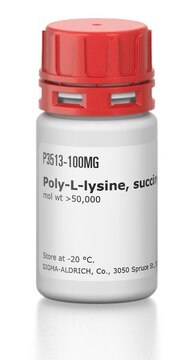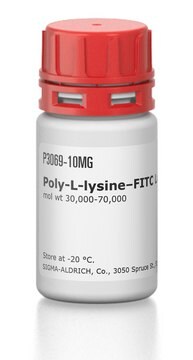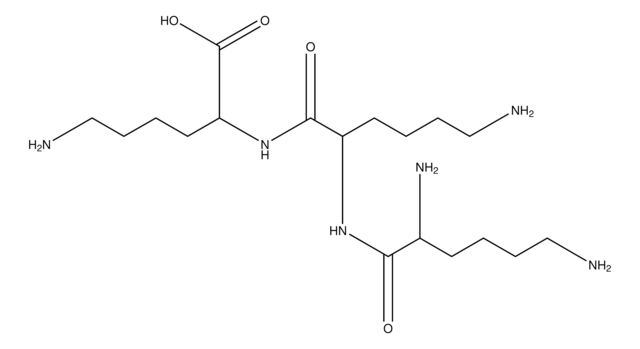おすすめの製品
アプリケーション
- Transfection by polyethyleneimine-coated microspheres.: This study explores the use of Poly-e-Cbz-L-lysine in coating microspheres with polyethyleneimine for enhanced cell transfection, demonstrating improved efficiency and potential applications in gene therapy (Manuel WS et al., 2001).
- Transfection of cells mediated by biodegradable polymer materials with surface-bound polyethyleneimine.: The research focuses on biodegradable polymer materials, including Poly-e-Cbz-L-lysine, for cell transfection, highlighting their biodegradability and effectiveness in delivering genetic material (Zheng J et al., 2000).
- Production of microspheres with surface amino groups from blends of Poly(Lactide-co-glycolide) and Poly(epsilon-CBZ-L-lysine) and use for encapsulation.: This paper discusses the creation of microspheres with surface amino groups using blends of Poly-e-Cbz-L-lysine, which are then used for encapsulating active agents, indicating applications in drug delivery systems (Zheng J et al., 1999).
- Modification of materials formed from poly(L-lactic acid) to enable covalent binding of biopolymers: application to high-density three-dimensional cell culture in foams with attached collagen.: The study examines the modification of poly(L-lactic acid) materials with Poly-e-Cbz-L-lysine to covalently bind biopolymers, facilitating high-density 3D cell culture applications (Zheng J et al., 1998).
アナリシスノート
分子量はエレクトロスプレー質量分析によるものです。
その他情報
ポリアミノ酸に関するさらに詳細な技術情報をお求めの場合は、ポリアミノ酸FAQをご覧下さい。
保管分類コード
11 - Combustible Solids
WGK
WGK 3
引火点(°F)
Not applicable
引火点(℃)
Not applicable
個人用保護具 (PPE)
Eyeshields, Gloves, type N95 (US)
適用法令
試験研究用途を考慮した関連法令を主に挙げております。化学物質以外については、一部の情報のみ提供しています。 製品を安全かつ合法的に使用することは、使用者の義務です。最新情報により修正される場合があります。WEBの反映には時間を要することがあるため、適宜SDSをご参照ください。
Jan Code
P4510-VAR:
P4510-1G:
P4510-100MG:
P4510-25MG:
P4510-500MG:
P4510-BULK:
この製品を見ている人はこちらもチェック
W S Manuel et al.
Journal of drug targeting, 9(1), 15-22 (2001-05-30)
Polyethyleneimine (PEI) can be used as a DNA delivery mechanism in cell culture and in vivo. Cells can be transfected by using surface-bound PEI, as well as by PEI/DNA microparticles. In the present experiments we extended these observations by preparing
Chimdiya Onwukwe et al.
Bioconjugate chemistry, 29(7), 2436-2447 (2018-07-03)
Bleeding from traumatic injury is the leading cause of death for young people across the world, but interventions are lacking. While many agents have shown promise in small animal models, translating the work to large animal models has been exceptionally
J Zheng et al.
Biotechnology progress, 16(2), 254-257 (2000-04-08)
Poly(epsilon-CBZ-L-lysine) can be mixed with biodegradable polymers such as poly(D,L-lactic-co-glycolic acid) or poly(L-lactic acid) and formed into films, foams, or microspheres. Surface amino groups may then be deprotected with acid or lithium/liquid ammonia. The amino groups serve as a method
Qian Guo et al.
Journal of controlled release : official journal of the Controlled Release Society, 303, 117-129 (2019-04-27)
Brain metastases present mostly multifocal, infiltrative and co-opting growth with the blood-brain barrier (BBB) remaining intact. The BBB, as the barrier of drug delivery to such lesions, is the major cause of the failure of systemic drug therapy and needs
J Zheng et al.
Biotechnology progress, 15(4), 763-767 (1999-08-12)
Microspheres were formed from blends of the biodegradable polymer poly(DL-lactic-co-glycolic acid) (PLGA) together with poly(epsilon-CBZ-L-lysine) (PCBZL) by a double-emulsification/solvent evaporation technique. The size of the microspheres formed by this method was dependent both on the total concentration of the polymers
資料
Humankind has utilized protein materials throughout its existence, starting with the use of materials such as wool and silk for warmth and protection from the elements and continuing with the use of recombinant DNA techniques to synthesize proteins with unique and useful properties.
ライフサイエンス、有機合成、材料科学、クロマトグラフィー、分析など、あらゆる分野の研究に経験のあるメンバーがおります。.
製品に関するお問い合わせはこちら(テクニカルサービス)






